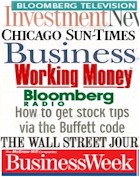The following are what we consider to be the
five main keys to Buffett’s methods of investing.
-
Businesses that you understand:
Focus on areas that you have the most background in
or the most interest in. Buffett, for example, does
not invest in tech companies because he says that he
does not understand the market for their product or
service. He focuses on ‘consumer’ foods,
newspapers, insurance companies and retail furniture
stores.
-
Strong economic moat:
Look for companies that have a protection against their
competitors. This could be geographical, patents, brand
name, entry costs, and so on. When companies have a
strong economic moat, then financial forecasts can be
more reliable. An example is Westfield Holdings. When
they build a new shopping centre, particularly in outer
suburban areas, then it is unlikely that another centre
will be built nearby.
-
Sales and earnings growth:
You can still get good returns from companies that have
poor growth figures if they pay out most of their earnings
as dividends or use them for share buybacks. Nevertheless,
at least a reasonable level of growth is often important
for the management and employees to have a sense of
achievement which then translates into higher productivity
and less unrest. I also look for companies with earnings
that have a high stability of sales and earnings growth.
-
Return on equity: If
you think of equity as your money, then return on equity
is a measure of how well management is doing with your
money. It is virtually impossible for a medium to long-term
investment to be satisfactory if the return on equity
is low. Look for companies that have 15% or more return
on equity and return on capital.
-
Not too much debt: If
debt is too high, then the company is vulnerable to
credit squeezes and may have difficulty in raising money
for expansion.
Using keys such as these, Buffett is looking
for what we call ‘great companies’. These are
companies that have done well in the past and have all the
hallmarks of doing well in the future.
Another important aspect of Buffett’s
approach is that he buys stocks as if he were holding them
for a life time – a bit like getting married. When
you pop the question, your intention is that it is going
to be forever It might not end up that way, but this is
what guides your decision.
On a number of occasions Buffett has referred
to himself as a ‘Rip Van Winkle’ investor, an
investor whose ‘favourite time frame for holding a
stock is forever’.
The final stocks are those with characteristics
like those described above: high return on equity and return
on capital, low debt, healthy capital structure, and stable
strong growing earnings and sales. These are quality businesses
that are potentially great investments, so long as they
can be purchased at a reasonable price.
These stocks are then analysed in more detail
using proprietary analysis and graphing tools to calculate
their return under different ‘margins of safety’.
|



